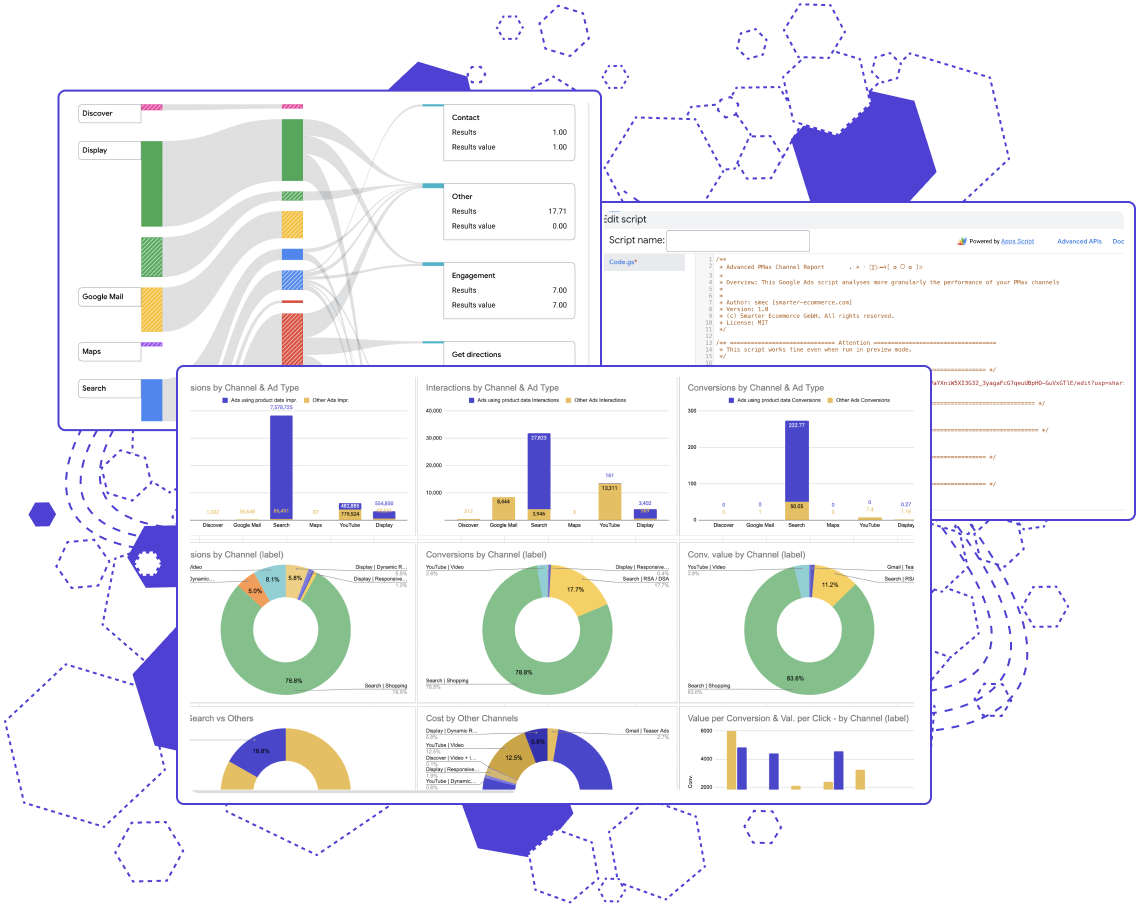Subscribe to join thousands of other ecommerce experts
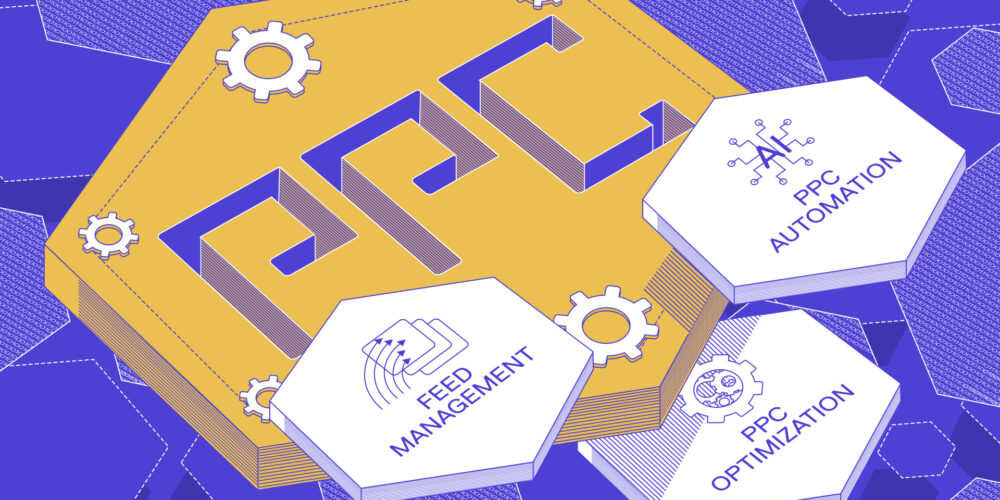
Ecommerce retailers are facing a perfect storm—soaring advertising costs, increasing competition, and AI-driven ad platforms like Google’s Performance Max (PMax) that promise automation but often at the expense of transparency and control.
Navigating this landscape requires more than just running ads—it demands the right strategy, tools, and expertise.
So, the big question is: What are your options to make the most out of your PPC ventures?
Are agencies the right fit for your business, or should you take a spin with one of the many PPC software tools out there? And if so, which one’s worth your time (and budget)?
To help you cut through the noise, we’ve put together a super-handy PPC buyer’s guide. Keep reading to find out how agencies stack up against software, what sets different software solutions apart, and how the biggest players in the market measure up.
Table of Contents
Overview:
- Agencies: When should you choose them?
- Feed Management Tools: Channable, Feedonomics, ProductHero
- PPC Automation Tools: Optmyzr, ROI Hunter, Adalysis
- PPC Optimization Tools: smec, Upp.ai
- What’s the best solution?
PPC Agencies vs. PPC software tools: What’s right for you?
There are two main approaches to AI-driven advertising:
- Outsource to an Agency → They handle the complexity for you, but you trade cost and control for expertise and execution.
- Use Specialized Software → Automation tools help you optimize, steer, and analyze campaigns, but they require some in-house knowledge.
Both agencies and software solutions aim to make AI-driven ad platforms work for you, but they do so in very different ways.
So, which option is better? It depends. Let’s break them down:
Agencies:
How can they support PPC ventures?
Agencies provide strategic expertise and hands-on campaign management, which is great if you lack time or in-house talent.
However, not all agencies are equal:
| 👾 Agency type | 🔎 Overview |
| Traditional agency | Their business model is stuck in the past, as it thrives on outdated, labor-intensive practices—like manual campaign building. |
| Hybrid agency | Hybrids Agencies blend traditional campaign management with consulting. They offer you a fair amount of data insights. |
| Tech-driven agency | These agencies integrate their own AI and ML technology, transforming into SaaS businesses that still act as a strategic partner. |
Agencies in the age of AI
The rise of AI-driven ad platforms has drastically changed the role of PPC agencies. Tasks that were once manual and labor-intensive, like bid adjustments and campaign structuring, are now largely automated by platforms like Performance Max (PMax).
This shift means retailers require less operational support from agencies and more strategic expertise. Many Agencies struggle to provide the level of control and scalability that can be achieved with specialized AI-powered software.
In fact, according to the latest State of PPC Report, businesses frequently leave agencies due to:
🚨 Dissatisfaction with value – High costs without a clear return on investment.
🚨 Dissatisfaction with delivery – Agencies often fail to meet expectations.
🚨 Staff turnover – Losing key personnel leads to declining service quality.
Many agencies struggle to provide the level of granular control and scalability that can be achieved with specialized, AI-powered software.
PPC Software Tools:
Top categories to consider
For businesses that want control but don’t want to spend hours on manual PPC work, software solutions provide the automation and intelligence to steer AI-driven ad platforms.
| 👾 Category | 🔎 Overview |
| Feed management tools | Optimize product feeds for Google, Meta, Amazon, and other marketplaces. |
| PPC automation tools | Handle bidding, budgeting, and campaign adjustments without constant human intervention. |
| PPC optimization tools | These go beyond basic automation by integrating business data, profitability, and cross-channel insights to align PPC with business goals. |
Let’s break each category and their key players down in detail to help you and your business make an informed decision:
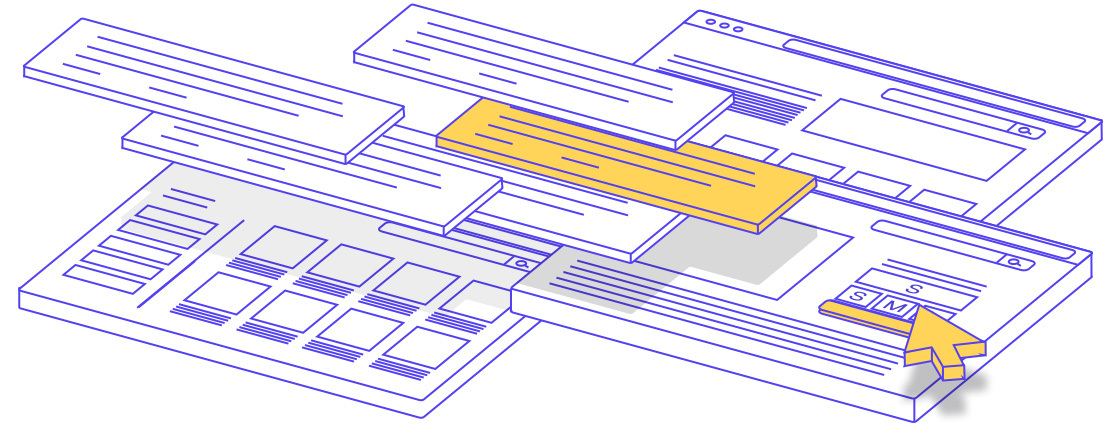
Feed Management Tools:
Channable, Feedonomics, ProductHero
Even the best campaign strategy can’t fix a bad product feed. Poorly structured product data leads to:
🚨 Higher CPCs due to irrelevant search terms
🚨 Disapproved products in Google Shopping
🚨 Mismatched pricing & availability, leading to wasted ad spend
What are they for?
Feed management tools clean, optimize, and distribute product data to Google Shopping, Meta, Amazon, Microsoft, and other ad platforms.
They help ensure that your product listings meet each platform’s requirements, reducing disapprovals and improving ad performance.
When should you choose them?
| ✅ Good choice if: | ❌ Bad choice if: |
| You need to fix, enrich, or standardize product data before it reaches ad platforms for better overall performance. | You need to control how ad spend is allocated—feed tools don’t handle bids, budgets, or placements. |
| You sell on multiple marketplaces (Google Shopping, Amazon, Meta, eBay) and need a single, synced feed. | You want deep campaign insights—feed tools optimize product data, not ad performance metrics. |
| You want to automate inventory-based product exclusions (e.g., pausing out-of-stock items). | You only sell on one platform and don’t need multi-channel feed distribution. |
What are the key players?
Channable
Channable is a feed management platform that helps ecommerce businesses optimize and distribute product data across marketplaces, comparison sites, and ad platforms like Google Ads and Microsoft Ads.
Its intuitive interface and custom rule-based automation simplify and enhance product feed optimization. This reduces manual effort and improving ad performance across multiple channels.
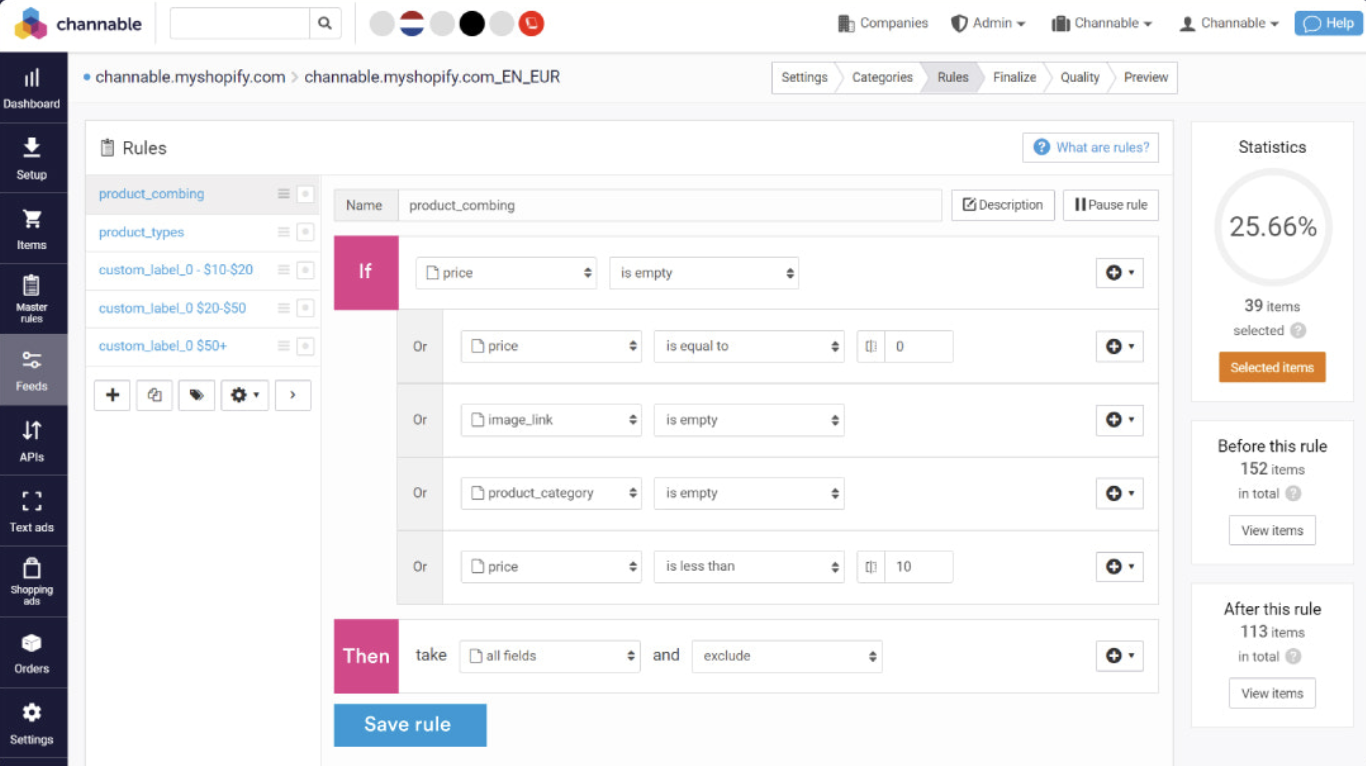
| ✅ Strengths | ❌ Weaknesses |
| Centralized feed management – Manage product feeds for multiple marketplaces, ad platforms, and comparison sites from a single dashboard. | Limited to feed management – Does not optimize bidding, budgeting, or campaign structure, meaning additional tools or manual adjustments are needed. |
| Customizable rules & automation – Offers powerful rule-based automation to optimize product listings, exclude low-performing items, and tailor feeds for specific channels. | Lacks strategic support – Provides a technical solution but does not actively guide businesses in developing broader advertising strategies. |
| Multi-channel integrations – Supports a wide range of integrations, including Google Ads, Microsoft Ads, Amazon, and more. | No campaign automation – All automation is related to feed management but not campaign-level optimizations. |
| Limited deep channel insights – Has limited insights into channel distribution and search term reports. |
Channable is a good fit for mid-sized retailers who need rule-based feed automation across multiple ad platforms but don’t require deep performance insights or hands-on support.
Feedonomics
Feedonomics is an enterprise-level feed management platform built for retailers with large catalogs and complex data needs.
It supports hundreds of integrations across marketplaces like Google Shopping, Amazon, and Walmart while offering fully managed services for real-time feed optimization and troubleshooting.
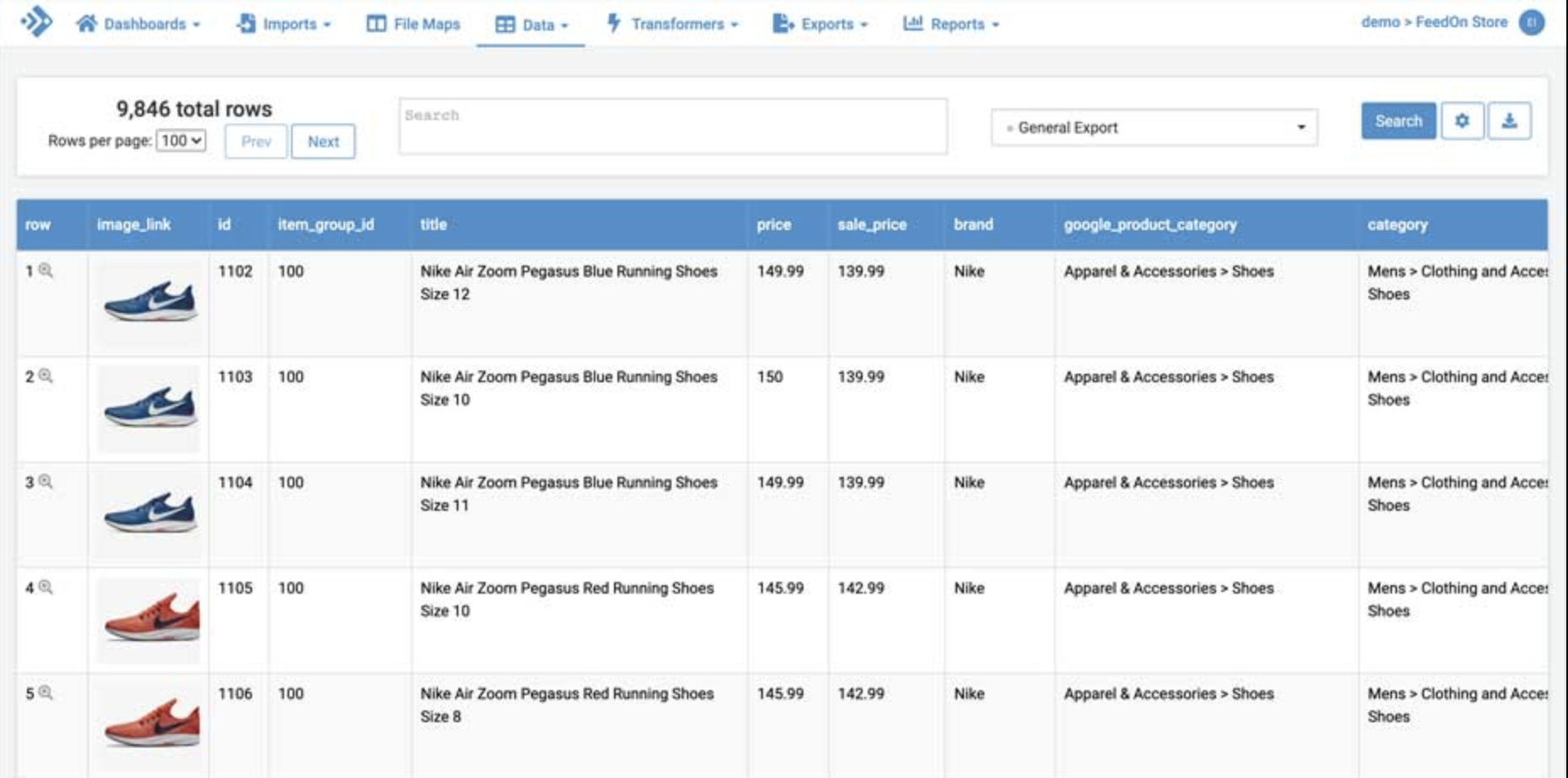
| ✅ Strengths | ❌ Weaknesses |
| Comprehensive channel support – Integrates with a wide range of marketplaces, advertising platforms, and comparison shopping engines, ensuring optimized product data distribution. | Limited to feed management – Does not offer PPC optimization tools such as budget recommendations, product segmentation, or advanced campaign insights. |
| Highly customizable – Enables customized product feed rules to meet channel requirements, enhance data quality, and improve campaign performance. | Steep learning curve – Due to its advanced features, setup and mastering the platform require a significant time investment. |
| Scalability & automation – Excels in handling large product catalogs by automating feed updates, inventory syncing, and listing accuracy. | No campaign automation – All automation is related to feed management but not campaign-level optimizations. |
| Limited deep channel insights – Has limited insights into channel distribution and search term reports. |
Feedonomics is ideal for large retailers needing hands-on support to manage complex feeds across multiple marketplaces. However, if you need bidding, budget control, or campaign adjustments, you’ll need additional PPC management tools.
ProductHero
ProductHero is a feed optimization tool designed exclusively for Google Shopping, leveraging Google’s Comparison Shopping Service (CSS) to reduce CPCs and improve ad performance.
It’s a solid choice for small-to-midsize businesses seeking better visibility without deep PPC expertise, but it lacks multi-platform support and the advanced features of more comprehensive feed management tools.
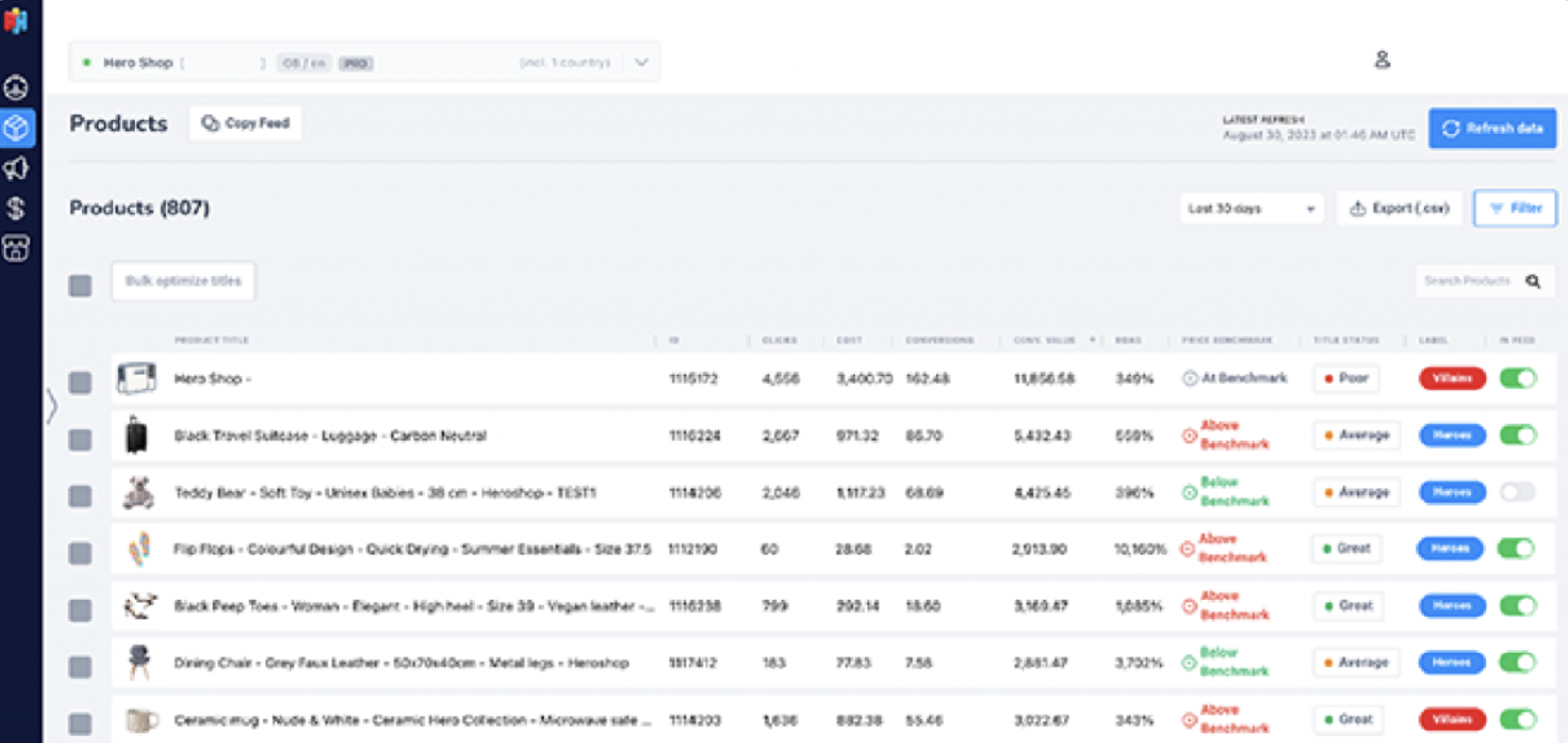
| ✅ Strengths | ❌ Weaknesses |
| Enhanced visibility with CSS integration – Leverages Google’s Comparison Shopping Service (CSS) to help retailers achieve better visibility and reduced cost-per-click (CPC). | Limited to Google Shopping – It does not support other Google Ads offerings (like PMax), nor Microsoft Pmax or Meta. |
| Simple & user-friendly interface – Designed for easy onboarding and management, making it ideal for businesses with limited technical expertise. | Historical data reliance – Making it less suitable for PPC Managers who want to optimize campaigns for profitability or new strategic products. |
| Product Labelizer – Uses Google Shopping performance data to segment products and prioritize high-performing listings. | Lacks strategic support – offers strong technical functionality but provides limited strategic guidance. Users are responsible for aligning CSS benefits with their business goals, which may be a consideration for those seeking more hands-on support. |
ProductHero is a good fit for small to mid-sized businesses focused solely on Google Shopping and looking to lower CPCs through CSS integration. However, if you need multi-platform feed management, deeper data optimization, or campaign controls like bidding and budget adjustments, it won’t be enough on its own.

PPC Automation Tools:
Optmyzr, ROI Hunter, Adalysis
Without automation, bidding, budget pacing, and keyword optimizations require constant manual adjustments, leading to:
🚨 Inefficient ad spend due to delayed bid adjustments
🚨 Missed opportunities as market conditions change in real time
🚨 Wasted time on repetitive tasks that could be automated
What are they for?
PPC automation tools streamline bid and budget management, helping not only advertisers, but also agencies to adjust to market fluctuations, competition, and performance trends without constant manual input.
They reduce workload for PPC teams while ensuring campaign efficiency across platforms like Google, Microsoft, and Meta Ads.
When should you choose them?
| ✅ Good choice if: | ❌ Bad choice if: |
| You need to automate bidding, budgets, and keyword adjustments. | You need profit-based campaign steering—automation tools optimize performance but don’t factor in margins or stock levels. |
| You manage large PPC accounts across multiple platforms. | You need deep product segmentation—they adjust bids but don’t optimize campaigns based on product lifecycle. |
| You want to reduce your in-house marketing team’s manual workload so they have more time for strategising. | You need full campaign management that’s ideally handled by AI – these tools automate execution but still require a lot of human oversight. |
What are the key players?
Optmyzr
Optmyzr is a PPC automation tool built for agencies and advanced PPC managers who need efficient, rule-based automation without losing control.
It streamlines bidding, budget pacing, and campaign adjustments across Google, Microsoft, and Amazon Ads, offering pre-built strategies and custom scripts for scalable optimizations.
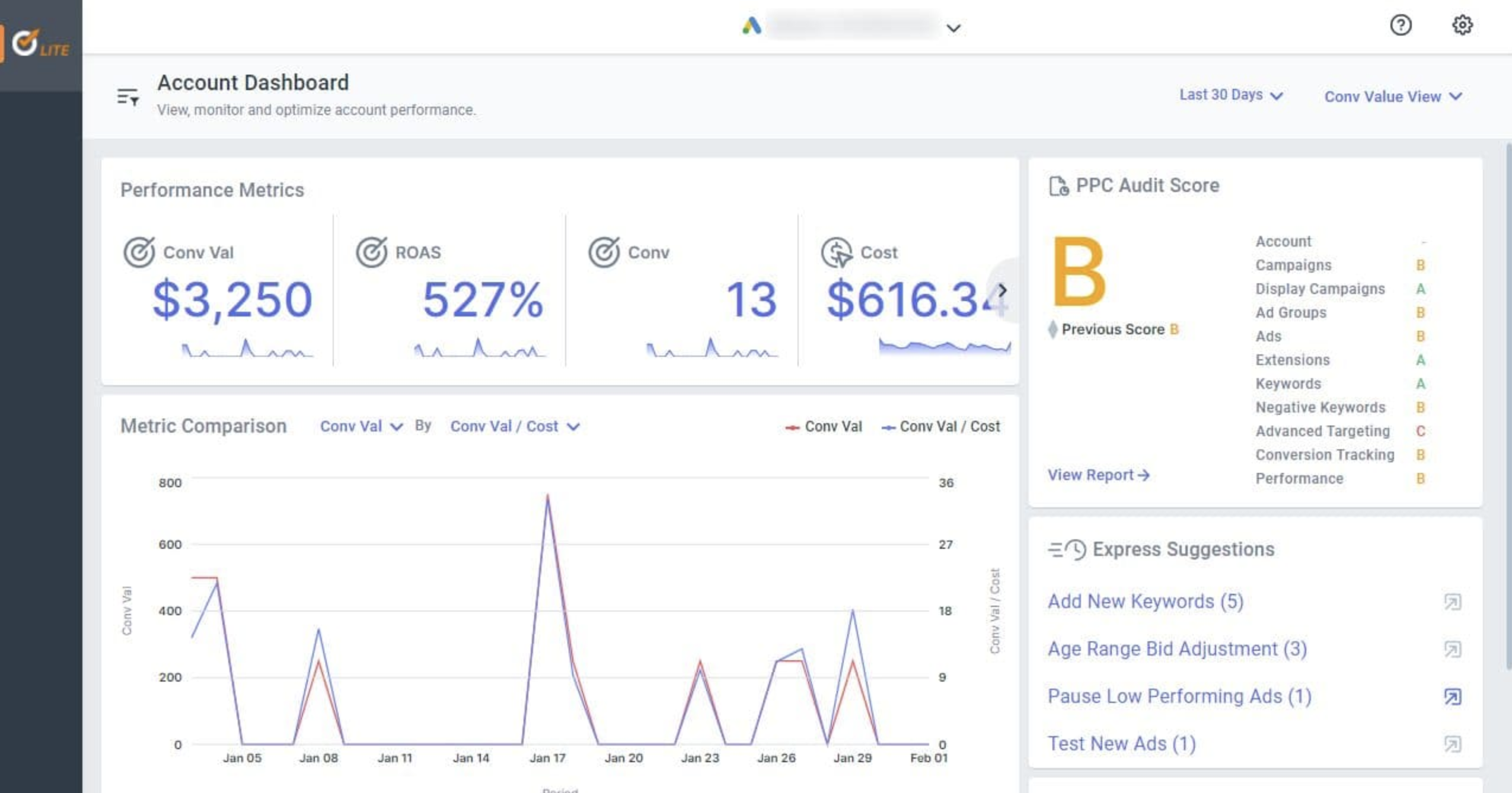
| ✅ Strengths | ❌ Weaknesses |
| Advanced automation – Offers pre-built scripts, automated bid management, and rule-based optimizations to save time and reduce manual workload. | Limited control over Performance Max – Lacks product segmentation features for PMax campaigns, reducing optimization flexibility. |
| Customization & flexibility – Advertisers and agencies can tailor workflows and reports to fit their unique campaign needs. | Steep learning curve – Due to its feature-rich platform, new users may find it overwhelming. Especially those unfamiliar with PPC scripts and automation. |
| Cross-channel management – Integrates with Google Ads, Microsoft Ads, and Amazon, providing a unified multi-platform interface. | Limited strategic support – Focuses on technical optimizations but does not provide dedicated strategic consulting. |
Optmyzr is a good choice if you need rule-based bid automation, budget pacing, and custom scripts to streamline PPC management across multiple platforms. If you’re looking for profitability-driven optimization, product-level insights, or AI-powered campaign steering, you’ll need additional tools.
ROI Hunter
ROI Hunter takes a unique approach to PPC automation by focusing on product performance analysis rather than just bid adjustments.
It identifies high-margin, top-performing products and reallocates ad spend accordingly, helping advertisers prioritize profitability over simple ROAS-based bidding.
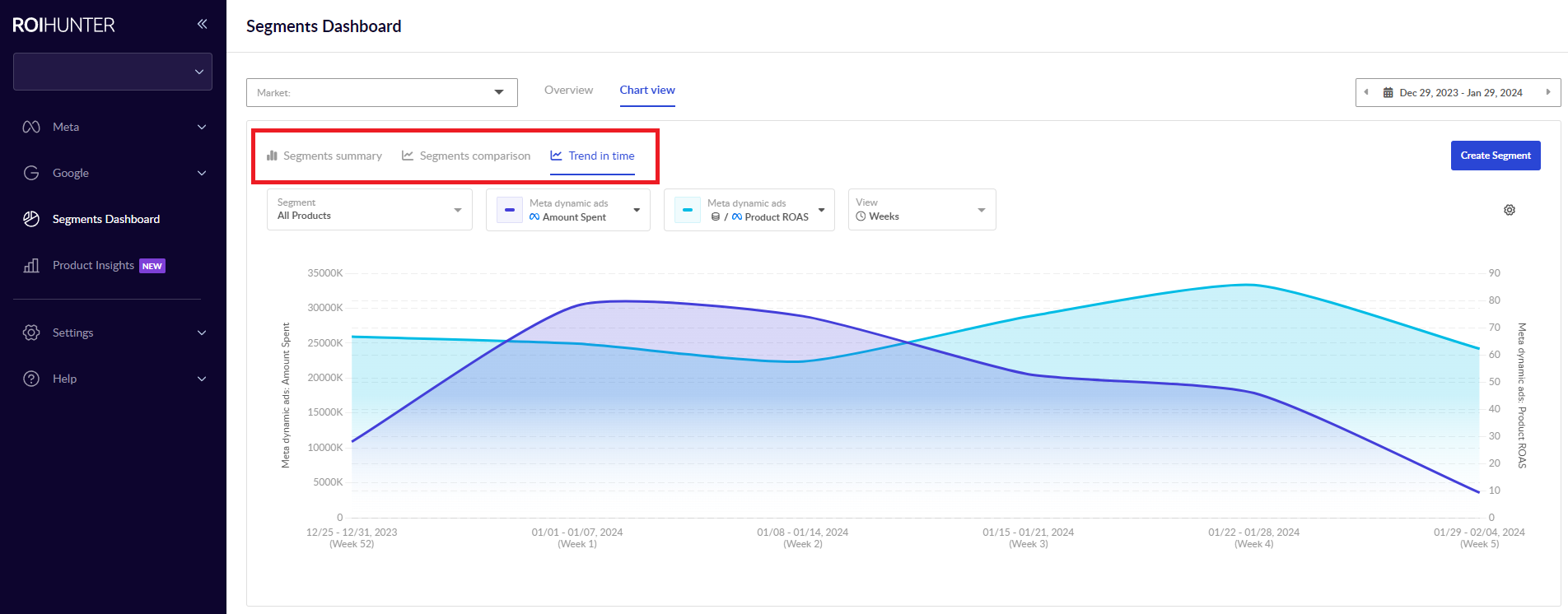
| ✅ Strengths | ❌ Weaknesses |
| Product-centric insights – Provides detailed product performance insights, helping e-commerce businesses identify high-value and underperforming products. | Lacking campaign optimization – Does not dynamically adjust budgets or tROAS to improve campaign performance. |
| Focus on profitability – Goes beyond ROAS by incorporating profitability-focused data, aligning advertising efforts with overall business goals. | Lack of channel-specific insights – Does not provide in-depth insights into channel distribution or search terms. |
| Multi-channel support – Integrates with Google and Meta, allowing businesses to optimize campaigns across different platforms. | No strategic support – Similar to Optmyzr, ROI Hunter focuses on technical optimization but doesn’t provide strategic consulting. |
| Steep learning curve – Advanced features like profitability analysis and product segmentation require time and expertise to master. |
ROI Hunter is ideal for ecommerce businesses looking to optimize ad spend based on product profitability. However, it does not optimize campaign performance (e.g., bid adjustments or budget allocation) and lacks channel-specific automation.
Adalysis
Adalysis is a highly specialized audit tool designed for continuous A/B testing and ad performance optimization in Google Search.
Unlike broader PPC automation platforms, Adalysis focuses exclusively on improving Search Ads through structured testing and data-driven refinements.
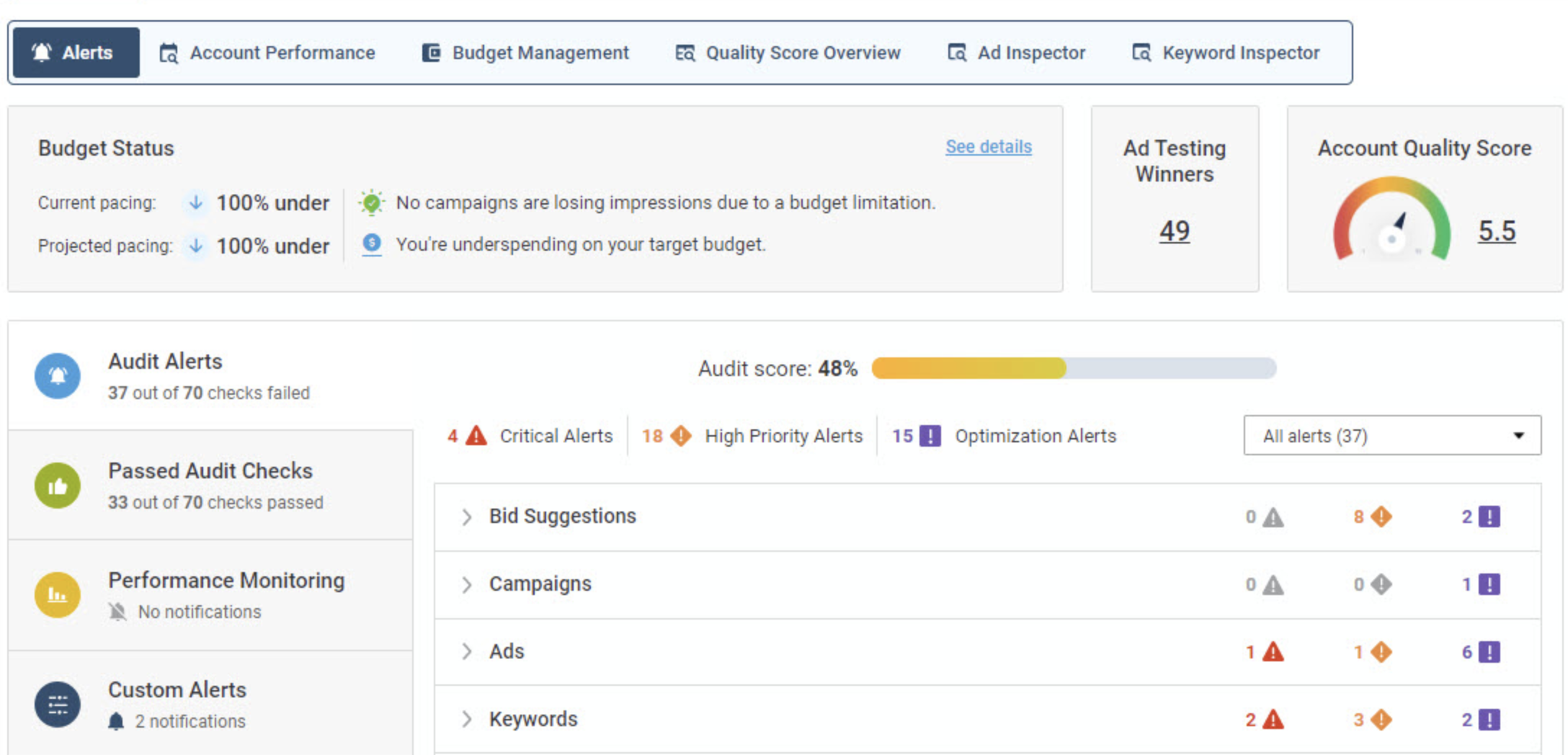
| ✅ Strengths | ❌ Weaknesses |
| Automated account audits – Identifies critical campaign issues and optimization opportunities automatically. | Limited PMax support – No optimization towards business goals! This audit tool is purpose-built for identifying poor performing assets, missing audience signals and misspelled asset texts. |
| Custom alerts & recommendations – Provides tailored alerts and insights for bid adjustments, keyword opportunities, and budget optimization. | Steep learning curve for beginners – Due to its feature-rich nature, new users may require additional time and effort to master the platform. |
Adalysis is ideal for Search-focused advertisers who want to systematically test ad creatives, refine keyword strategies, and improve Quality Scores through automated A/B testing and negative keyword management. However, businesses relying on Shopping Ads or needing cross-platform automation should look elsewhere.
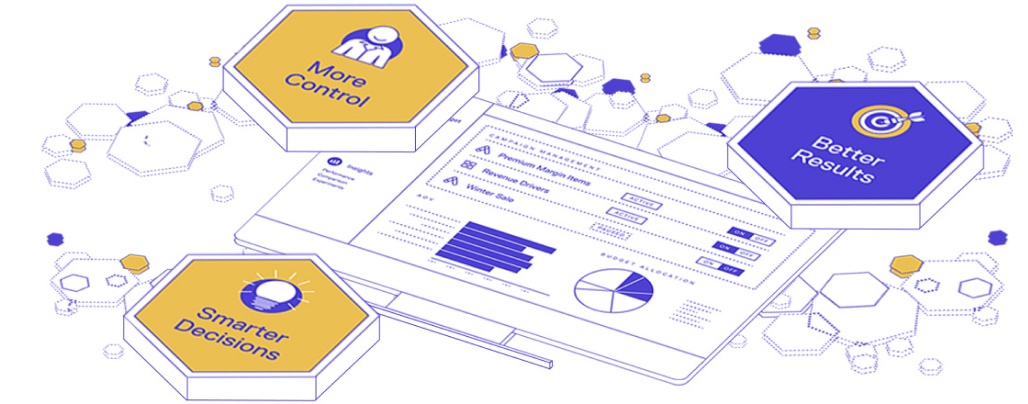
PPC Optimization Tools:
smec, Upp.ai
PPC optimization tools enhance AI-driven ad platforms like Performance Max (PMax), ensuring your campaigns align with long-term business growth goals. By integrating business intelligence into PPC management, these tools offer:
✅ Smarter budget allocation by prioritizing high-margin and strategic products
✅ Better campaign efficiency through AI-driven bid and budget optimization
✅ More control over AI automation, allowing advertisers to steer campaigns based on real business performance
What are they for?
Unlike standard PPC automation tools that adjust bids and budgets, PPC optimization tools take automation further by integrating profitability data, stock levels, and multi-channel insights into campaign decisions.
They allow advertisers to fine-tune Performance Max, Shopping Ads, and Search campaigns based on product performance, margins, and demand, helping maximize ROI while maintaining full strategic control.
When should you choose them?
| ✅ Good choice if: | ❌ Bad choice if: |
| You need AI-driven budget and bid optimization based on profitability. | You only need basic bid and budget automation—a simpler PPC automation tool may be sufficient. |
| You want to feed PMax multiple critical business data-points to push high-margin, high-demand, and/or strategic products. | You only run small-scale campaigns with a limited product catalog. |
| You manage large ecommerce PPC campaigns and need to align ad spend with business KPIs. | You prefer fully manual control over every aspect of campaign execution. |
| You need cross-channel insights for Google, Microsoft, and Amazon Ads. | You rely mainly on Google Shopping and don’t need broader PPC optimization. |
What are the key players?
smec – Smarter Ecommerce
smec (Smarter Ecommerce) is an advanced PPC optimization tool designed to give advertisers control over AI-driven ad campaigns while aligning campaign strategies with real business objectives.
By leveraging multi-dimensional product segmentation, smec ensures ads prioritize profit margins, demand, and business value—not just past performance.
First-party data integration (like inventory levels and customer lifetime value) steers ad spend toward high-impact areas, while smart budget distribution ensures budgets are allocated based on overall account performance rather than individual campaign recommendations.
Real-time AI adjustments automate bid and budget decisions, focusing spend on high-value products and cutting waste. Plus, detailed performance insights break through Google’s black-box reporting, giving advertisers the clarity they need to make smarter, data-driven decisions.

| ✅ Strengths | ❌ Weaknesses |
| More control over PMax campaigns – Provides advanced segmentation and product goal setting, allowing advertisers to steer Performance Max campaigns effectively. | Requires configuration – Not a plug-and-play solution; businesses need to define goals and inputs for optimal results. |
| Profitability-driven optimization – Uses AI-powered recommendations to allocate budgets and adjust tROAS dynamically based on business objectives. | Best for mid-to-large retailers – May not be ideal for businesses with small product catalogs or limited ad spend. |
| Expert human support – Acts as an extension of in-house teams, providing access to 40+ PPC experts with deep industry knowledge. | Focused on Google & Microsoft PMax – Businesses focused on Meta, TikTok, or other social platforms may need additional tools. |
smec is ideal for retailers managing large product catalogs who want more control over AI-driven ad platforms like Performance Max. By integrating strategic business data like profit margins, stock levels, customer lifetime value, or warehouse logistics into campaign decisions, it ensures ad spend works to improve online retailers' bottom line.
Upp.ai
Upp.ai is an AI-driven e-commerce platform designed to optimize and automate paid search campaigns for online retailers. It leverages advanced algorithms to analyze product performance, customer behavior, and campaign data in real time.
The platform’s core philosophy is that AI can drive better business results than human-led optimizations, focusing on automation over manual adjustments.
Unlike other PPC tools that offer a mix of automation and strategic support, Upp.ai is fully committed to AI-driven decision-making, minimizing the need for human intervention.
It integrates with Google, GA4, Merchant Center, and Meta, enabling advertisers to feed AI with cross-channel signals to refine ad targeting.
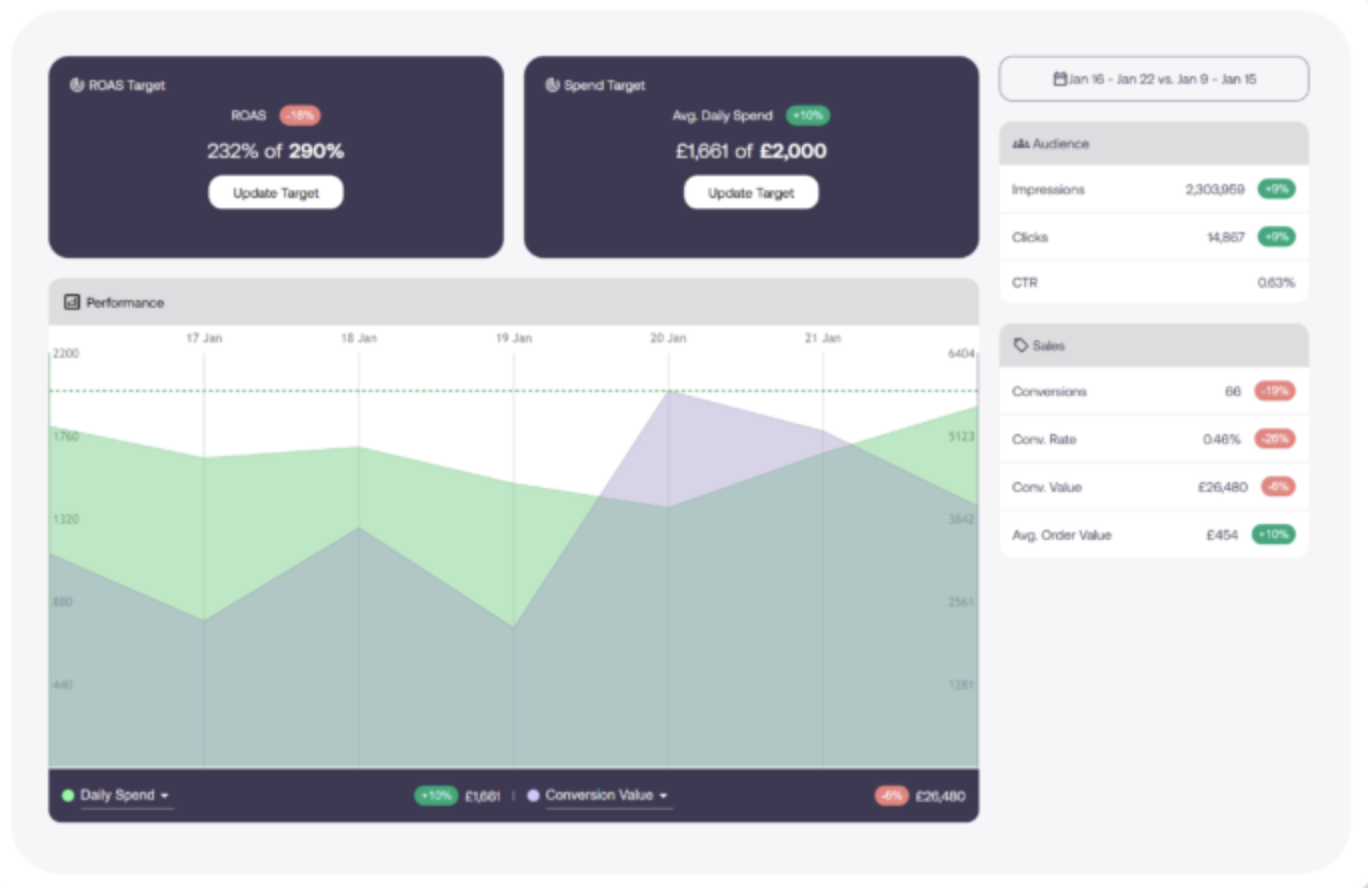
| ✅ Strengths | ❌ Weaknesses |
| AI-driven automation – Uses real-time AI algorithms to optimize advertising decisions and reduce manual workload. | Lack of strategic support – Offers minimal human consulting or strategic guidance, relying fully on automated campaign management. |
| Cross-channel data – Connects product data from GA4, Merchant Center, Google Ads, and Meta to inform ad optimizations. | Google-only campaign management – Cannot manage Microsoft, Amazon, or other non-Google ad platforms. |
| Ease of use – Simple, intuitive interface makes campaign management straightforward, requiring minimal PPC expertise. | Limited control – Businesses wanting manual campaign steering may find Upp.ai’s automated nature too restrictive. |
Upp.ai is best for mid-to-large-sized ecommerce businesses looking for an easy-to-use AI tool that automates budget allocation. Advertisers needing cross-channel optimization, deep product segmentation, or manual control over bid strategies may find it too limited for complex PPC management.

What’s the best solution?
As you can see, the PPC automation landscape is packed with tools—some specializing in feed management, others in bid automation, and a few aiming to bring everything together into a single, cohesive solution.
Truth being told, we firmly believe that getting the most out of your PPC campaigns requires more than just a single-point solution. That’s why we champion the “goldilocks” approach—offering a rich set of features in one powerful, AI-driven platform that balances automation with control.
That being said, there’s something to be said about specialized platforms that do one thing really well.
Get the right tool for the job!
If all you need is to clean up and distribute your product feeds, then tools like Channable or Feedonomics might be the perfect fit. If you’re just looking for bid automation, Optmyzr or ROI Hunter could get the job done.
However: if you’re ready to take a big step forward—to optimize beyond ROAS, align ad spend with profit margins, and steer AI-driven campaigns with true business intelligence—then you need a platform that goes further.
We’d love to show you how smec can help you take back control of your PPC strategy and drive profitable, sustainable business-growth!
FAQ
The best Google Ads management software for retail should do three things well:
• automate repetitive tasks
• provide granular control over campaign performance, and
• align ad spend with business goals
Software that integrates AI-driven optimization with human oversight is ideal, as fully automated solutions often lack strategic flexibility.
Depending on your needs, PPC automation tools handle bid management, while PPC optimization platforms focus on profitability and cross-channel insights. Find out the best 2025 solutions in our extensive Buyer Guide.
Since Performance Max (PMax) is highly automated but lacks transparency, the best software should compensate for this by offering enhanced data integration and control mechanisms.
Look for tools that:
• Allow multi-dimensional product segmentation, so you can push strategic products and not just best-sellers.
• Provide profitability-based campaign steering, integrating margin data instead of focusing only on ROAS.
• Offer cross-channel insights, so your Google Ads don’t operate in isolation.
Retailers with large product catalogs need a scalable and data-driven solution. The ideal software should:
• Segment products dynamically based on sales, stock levels, and profitability.
• Automate campaign structuring to keep product groups optimized without constant manual input.
• Ensure feed hygiene, meaning product data remains up to date across Google, Microsoft, and marketplaces like Amazon.
For Google Shopping success, a tool should go beyond just cleaning and syncing product feeds. While feed management platforms like Channable or Feedonomics handle distribution, an advanced solution would:
• Optimize bids based on product performance, not just send clean data.
• Automate inventory-based exclusions, preventing wasted ad spend on out-of-stock products.
• Enrich product listings dynamically, adjusting attributes like pricing and descriptions based on real-time insights.
PPC automation software reduces manual workload by handling bid adjustments, budget pacing, and campaign structuring.
The best tools also offer:
• Predictive AI modeling to allocate budget where it’s most effective.
• Real-time performance monitoring, alerting users when manual intervention is needed.
• Cross-channel optimization, ensuring spend is adjusted dynamically across Google, Microsoft, and Meta Ads for the highest returns.
Still undecided?
We’ve created 5 quick-fire comparisons where we size up smec vs. other major players. No sugarcoating, just clear pros, cons, and what you should really consider.
Check out the deep-dives below:



